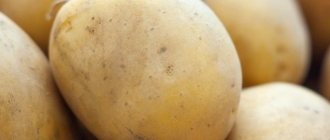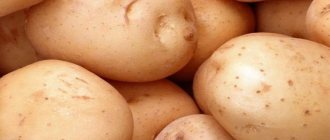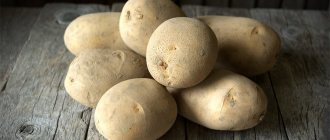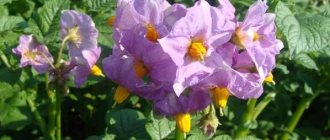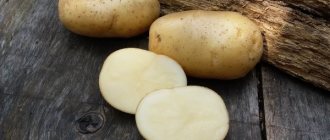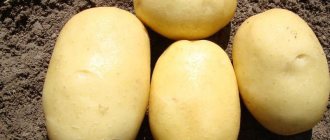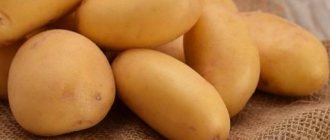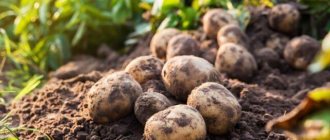The early-ripening variety Impala is of high value both for amateur gardeners and for owners of large farms involved in growing potatoes on a large scale. We will talk about the features, advantages, cultivation technology and measures of protection against all kinds of diseases and pests in more detail later in the article.
History of the variety
The history of the origin of the Impala variety began in the Dutch administrative center called Emmelord. Employees of the international company Agrico, which since 1973 has been widely known throughout the world for its innovative developments in the field of potato growing, obtained this potato variety through selective breeding.
In 1992, based on the results of variety trials, Impala was included in the State Register of Plants of the Russian Federation. In 2000, it was included in the State Registers of Ukraine and the Republic of Belarus. In the Russian Federation, the cultivation of the Impala potato variety is limited to four regions, such as:
- Volgo-Vyatka (Kirov, Nizhny Novgorod and Sverdlovsk regions; Republic of Mari El; Perm Territory; Udmurt and Chuvash Republics).
- Nizhnevolzhsky (Astrakhan, Saratov and Volgograd regions; Republic of Kalmykia).
- Northwestern (Vologda, Kaliningrad, Kostroma, Leningrad, Novgorod, Pskov, Tver and Yaroslavl regions).
- Central (Bryansk, Vladimir, Ivanovo, Kaluga, Moscow, Ryazan, Smolensk and Tula regions).
However, despite this, the Impala variety has become widespread throughout the Russian Federation. In some regions of the Russian Federation and Ukraine they gave it simpler and more familiar names - Kubanka or Krymchanka.
Reviews of Impala potatoes
Svetlana Mirgorodskaya, 37 years old, Krasnodar
I have been planting Impala potatoes in my dacha for 4 years. Satisfied with the taste, the variety is not difficult to prepare, retains its shape (does not get overcooked). Suitable for frying and baking. There is one drawback: you cannot use seeds from an area of more than three plantings; they must be replaced. The variety is degenerating, producing fewer tubers and becoming smaller.
Irina Sarantseva, 46 years old, Kaluga
I’ve been planting potatoes for a long time, I’ve tried different varieties, and there hasn’t been a single season where the crop hasn’t gotten sick. I read reviews about Impala potatoes, purchased seeds, and planted them. The result was pleasantly surprising, the bushes were strong, they never got sick, and the harvest turned out to be good. There were practically no small tubers in the bush. I was pleased with the taste, I’ll see how the variety performs in storage.
Description of the Impala potato
Bushes. The height of the potato bush reaches 75-80 cm. The plants are erect, with 4-5 well-leafed stems on each bush. The leaves are medium in size, quite dense and colored a rich green color. A slight waviness can be observed along the edge of the leaf. The flowers grow white with a small yellow center.
Roots. As a rule, about 15 tubers are formed on each bush. The root crops are large, oval and sometimes round-oval in shape. The bulk of the tubers gain until August. Their average weight is 90-160 grams. The peel is yellowish in color, characterized by smoothness and ease of cleaning due to its loose structure. The number of ocelli is moderate. They are very small and lie shallow on the surface of the peel. The pulp is light yellow, creamy.
Description
Potato bushes grow up to 75 cm. They are bushy, with a lot of medium foliage on 4 or 5 stems. It is rich green. The edges of the leaves are slightly wavy. The inflorescences contain white flowers with a yellow center.
Potatoes are oval with small eyes. They are only slightly recessed into the vegetable, which has a light yellow skin that is smooth to the touch. 1 vegetable weighs from 120 to 160 g, but there are also smaller or larger specimens.
Impala is a mid-early variety. It is believed that vegetables fully ripen from 60 to 75 days after potato sprouts sprout. .
"Important! You can dig up and eat vegetables from day 45.”
Gardeners who plant these fruits for the first time are pleased with them. They are beautiful and delicious. You can thoroughly stock up on them for the winter.
Characteristics and features of the variety
Let's consider the features and main characteristics of the Impala potato variety according to the following criteria:
- Rate of maturation. This is an early ripening potato variety. The first harvest will be available for harvest 45 days after planting. Depending on the climate zone, full ripening occurs in 60-70 days.
- Resistance to adverse weather conditions. The Impala variety tolerates both dry weather and high humidity conditions. Due to this property, it is widely distributed in various regions.
- Resistance to mechanical damage. The high resistance of root crops to mechanical damage allows them to completely preserve their original appearance after harvesting.
- Demanding requirements for soil. Potatoes of this variety are characterized by unpretentiousness to the type of soil, however, as practice shows, better results can be achieved when grown in unprotected soil.
- Keeping quality. Suitable for both consumption and storage for a long period of time. During long-term storage, it retains its properties and presentation well.
- Disease resistance. Impala is resistant to most viruses and diseases that often affect other potato varieties. This property is due to the fact that early ripening makes it possible to avoid many potato diseases that actively develop with the arrival of autumn. The table shows the main diseases and the degree of resistance of this variety to them :
| High stability | Medium stability | Low stability |
| Golden potato nematode | Common scab | Rhizoctoniosis |
| Potato cancer | Late blight of tubers and tops | Powdery scab |
| Viruses A and Yn |
Advantages, with disadvantages
In Russia, Impala potatoes are grown both in villages and by summer residents. It has many advantages, which is why it has become popular.
Let's look at the main ones:
- The variety ripens early. Depending on whether the southern region or the central region is different, how warm it is there, the seed material will need 45-75 days to grow.
- Even and smooth vegetables have a marketable appearance.
- Regardless of weather conditions, the harvest will be good. In the south you can collect 2.
- It grows well both in temporary drought and in abundant rain. This means that root crops can be grown in many regions of Russia.
- Various soils are suitable. There will be more fruits in open soil than in a greenhouse.
- Potatoes are used in the preparation of 1, 2, various dishes and snacks.
- Vegetables are stored for a long time and look great, maintaining high taste.
- Potatoes are resistant to physical damage. The owner collects the harvest and sees that 98% are in excellent condition.
- Resistance to neoplasms, with nematode.
- In 50 days, the potatoes grow large and can be harvested.
- If there is a lot of rain during the season, the potatoes will suffer from some diseases. The main thing is to use the right agricultural technology and all problems can be solved.
The good thing about Impala potatoes is that you can plant even unheated and unsprouted tubers in the ground.
"Important! They will sprout no worse than sprouted seed material. But the harvest will be smaller, so it’s better to germinate potatoes.”
Productivity and taste
Impala potatoes have not only high, but also stable yields. Farmers harvest from 180 to 360 centners of root crops per hectare of land per season. Amateur gardeners get a harvest from one bush - at least 0.5 kg with early ripening, and from 1 to 2 kg of already ripened potatoes.
In the southern regions, it is possible to ripen two harvests per year. For this purpose, the bushes are carefully removed from the soil, the tubers are removed, the hole is watered abundantly, and the bush with the remaining small tubers is planted back into it. The main condition is to perform these actions in cloudy weather.
The variety is intended for table use and has a rather low starch content (10-14%). After heat treatment, the potatoes become moderately soft, but do not become overcooked or darken. In this regard, it is perfect for consumption in any form (boiled, baked, fried). Due to their excellent tasting properties, Impala potatoes can be used for preparing both first and second courses, as well as for salads.
Main advantages of the variety
Impala has a lot of advantages, thanks to which it has been pleasing more than one family with its presence on the table for many years. Among the main advantages are:
- Early maturation. Harvesting usually begins at the beginning of the 3rd month after planting. But you can dig for testing already 1.5 months after planting.
- High yield. Entrepreneurs love it for 3 qualities: early ripening, high yield and pleasant taste.
- Adaptability. It adapts to any climatic conditions. The root crop develops well in both dry and moist soil.
- Soil requirements. Potatoes grow in any type of soil. Starting from black soil and ending with sandy loam. Purpose. Absolutely any manipulation is done with the variety. It is boiled, prepared in salads, fried, and mashed. In any form, the Impala will look great.
Advantages and disadvantages of the variety
The main undeniable advantages of Impala potatoes include:
- precocity;
- consistently high productivity;
- drought and moisture resistance;
- high transportability and keeping quality;
- resistance to mechanical damage;
- excellent taste of root vegetables;
- unpretentiousness to planting soil;
- versatility in cooking and cooking methods;
- attractive presentation;
- compact arrangement of tubers on bushes, which allows you to quickly and with minimal effort collect root crops;
- high resistance to major diseases.
Among the disadvantages of the variety, we note the following:
- susceptible to damage from the Colorado potato beetle, and therefore requires additional treatment against pests;
- seeds are not available for sale in all regions;
- It is necessary to carry out preventive measures aimed at protecting against fungal diseases.
How to grow a variety
Impala potatoes are grown in light, slightly moist soils with a moderate amount of nitrogen. The variety's agricultural technology is standard: moderate watering, loosening, weeding, hilling and fertilizing with organic matter and minerals.
Dates, scheme and rules of planting
The planting material does not need to be germinated before being planted in the ground , but this procedure promotes the rapid formation of sprouts. To do this, the tubers are taken out of the cellar, seeds with signs of rot are discarded and laid out in an even layer in a bright room. The air temperature for the first week should be +18…+25°С, then +12…+15°С.
The area for planting is prepared in the fall : it is dug up and fertilized with manure.
In spring, the soil is loosened and holes are formed. Work begins in the second ten days of April or early May, after waiting for the soil to warm up to +7°C. For rapid development of the root system and tubers, the optimal air temperature is +22...+25°C. The growth of tubers stops in heat (from +25°C) or light frosts (–2…–3°C). For planting, medium-sized seeds with many eyes are used .
First, the tubers are soaked for 30 minutes in a weak solution of potassium permanganate or boric acid and dusted with ash to reduce the risk of fungal infection. To stimulate growth, use "Epin" or "Zircon". Seedlings try not to break off, as this slows down the development of the plant and reduces productivity. The depth of planting potatoes is 6–8 cm with an interval of 30 cm. The distance between rows is 50 cm.
The furrows are located in the direction from north to south . In this way, it is possible to achieve maximum illumination of the plantings.
Reference. Impala potatoes are resistant to damage and retain up to 98% of the fruit's marketable appearance due to its dense skin.
Care
Rules of care:
- Crop rotation . Potatoes cannot be planted every year in the same place or in areas where tomatoes, eggplants, and peppers grew. The best predecessors are wheat, rye, oats, beans, lupine, peas, rapeseed, mustard, and sweet clover.
- Watering . Water consumption per 1 m² - 40 l. In moderate weather, it is enough to water once every 10–12 days. During drought, the frequency of watering is increased and sprinkling is done.
- Loosening . The procedure is carried out without fail, shallowly, trying not to touch the roots and tubers.
- Hilling up . The first time is carried out for bushes 20 cm tall, and after flowering it is repeated.
- Mulching . This procedure is optional, but it reduces the evaporation of moisture from the soil, stops the growth of weeds, and eliminates frequent weeding. For this purpose, black agrofibre, hay, straw, sawdust, and peat are used.
Plants are fertilized three times over the entire season according to the following scheme::
- at the beginning of the growing season, apply 1 tsp under the bush. ammonium nitrate, 300 g of humus per 1 bush or mullein infusion (1:10);
- during budding, add 50 g of ash, 10 g of potassium sulfate per 1 bush;
- after flowering (foliar feeding) - 30 g of superphosphate, 200 g of mullein/10 l of water.
Other potato varieties and hybrids:
Mid-early table potatoes "Gourmet" purple
Potatoes with good keeping quality “Kyiv Svitanok”
Unpretentious in care and high-yielding potatoes "Agatha"
Nuances of cultivation and possible difficulties
Impala potatoes are grown using Dutch technology , which allows you to get maximum yield with minimal labor costs.
Its essence lies in the complete abandonment of beds with holes in favor of long furrows. Technology advantages :
- Tubers are buried to a depth of 15 cm to ensure free access of oxygen to the roots.
- Moisture does not accumulate in the soil and the rhizome does not rot.
- Plants receive a sufficient amount of ultraviolet radiation, and this has a positive effect on productivity.
- The yield from one bush reaches 2 kg of selected tubers.
Landing rules:
- Seeds are planted in the furrows immediately after preparing the soil, preventing it from drying out.
- 6–8 tubers are planted per 1 m² with their sprouts facing up.
- Fertilizers (humus, ash) are placed at the bottom of the furrows, and tubers are placed on top.
- The width between rows is 70–80 cm, the gap between bushes is 25–35 cm.
- The first shoots are covered with earth, creating ridges 8–12 cm high. After 30 days, the procedure is repeated, forming elevations of 25–30 cm.
- Herbicides Centurion, Titus, Lazurit are used to control weeds.
- The area is watered three times: before flowering, 10 days after the flowers appear, at the end of flowering. A drip irrigation system will help reduce labor costs.
Diseases and pests
The Impala variety is resistant to cancer, viruses, scab and nematodes, but is susceptible to late blight and rhizoctonia. The table shows the main symptoms of infection, methods of prevention and treatment .
| Disease | Signs | Treatment | Prevention |
| Late blight | Dark spots and white pubescent coating on the leaves, traces of gray rot on the tubers, wilting of the plant. | Spraying with Bordeaux mixture, Ridomil Gold, Oxyx, Bravo. |
|
| Rhizoctonia (black scab of tubers) | Dark, deep spots, reticular tissue death. | Treatment with “Maxim” and “Quadris” products. |
|
Potato plantings are often affected by pests - spider mites, aphids, cicadas, and Colorado potato beetles. The table shows ways to get rid of pests on the site .
| Pest | Fighting methods |
| Aphid | Spraying with “Aktara”, “Confidor”, “Aktellik”, infusion of elecampane (200 g of dry roots / 10 l of hot water, leave for 3 hours). |
| Spider mite | Spraying with “Vertimek”, “Bikol”, ammonia (60 ml of ammonia, 25 ml of liquid soap/10 l). |
| Cicada | Irrigation of bushes using Movento Energy, Tabu, Akarin, Calypso, Proteus. |
| Colorado beetle | Treatment with fungicides “Aktara”, “Killer”, “Korado”, “Ultor”, infusion of walnut leaves (300 g of dry leaves/10 l of hot water, leave for a week), dusting with corn flour, gypsum, birch ash. |
Features of planting and growing Impala potatoes
In order to obtain the highest possible results from growing this variety, you should familiarize yourself with the necessary agrotechnical measures.
Optimal timing and location selection
Experts recommend planting potatoes in late April - early May. During this period, the soil already has time to warm up to the required temperature, and the humidity is still maintained at a sufficient level. Planting should be done after the end of return frosts. To get two harvests per season, in the southern regions of the Russian Federation, the Impala variety begins to be planted in late February - early March under spunbond.
The key rule in potato cultivation is compliance with crop rotation.
Areas where winter crops, legumes and perennial grasses previously grew are considered favorable for planting. Planting after crops belonging to the nightshade family (for example, tomatoes, peppers, eggplants) is unacceptable. It is also strictly forbidden to grow potatoes in one place for several years in a row. It is recommended to grow in light to medium soils that are not too waterlogged.
Preparing the site for planting
For planting the Impala variety, as for any other, it is very important that the soil is fertile and loose. To get an optimal harvest, you should enrich the soil with nutrients.
Impala responds well to mineral fertilizers. It would not be a bad idea to add a moderate amount of nitrogen to the soil in the fall, and in the spring, when planting tubers, you should add wood ash as a good tuber antiseptic and potassium fertilizer.
Tuber preparation
It is recommended to start germination in the second decade of March. Tubers of medium size (up to 5 cm) and weighing 50-80 g, on which there are many eyes, are used as seed material. Tubers of larger diameter should be divided so that each half retains some of the pulp and a stocky sprout.
A prerequisite is the selection of only healthy tubers, without rot, deformation and signs of any diseases. In order to increase the number of eyes, it is recommended to perform ringing - a transverse cut is made in a circle at the top of the tuber.
The seed potatoes are then placed in a bright place in a box for further germination. For the first few days, the temperature in the room must be maintained at +18...+25 °C, then it is reduced to a level of +12...+15 °C and maintained on an ongoing basis for another 30 days. Additionally, the level of illumination is also increased. Once every few days, potato tubers must be sprayed with water to maintain high humidity.
It is not necessary to pre-heat and germinate the planting material, but in this case the period of its maturation increases.
Seed potatoes that have not sprouted or have rotted should be monitored and discarded.
To prevent the occurrence of possible diseases and, as a result, ensure a higher yield, seed material should be treated with available means such as potassium permanganate, boric acid or wood ash. When the tubers completely germinate, they are placed in a special solution for 30-40 minutes. After this, the seed tubers must be ventilated.
Options for preparing a solution for 10 liters of water can be as follows:
- 1 g potassium permanganate;
- 10 g each of copper sulfate and zinc sulfate;
- 50 g boric acid.
The solution must not be prepared in metal containers.
Chemical treatment is also widely used, but it must be taken into account that it has a rather harmful effect on the resulting crop.
Another simple and inexpensive method of disinfecting and enriching tubers with nutrients is dusting them with wood ash. To do this, before planting, place 2 tablespoons of wood ash in each dug hole.
Planting in the ground, planting pattern and depth
When planting tubers, you should adhere to the following basic rules:
- The depth of the hole is no more than 6-8 cm.
- 200 g of wood ash is added to each hole.
- The tubers are placed with the sprouts facing up.
- The height of the soil ridge raised above the tubers should be 8-10 cm.
- It is preferable to place the furrows from north to south, so that a sufficient amount of sunlight will reach the bed. This helps to increase the overall yield, as well as an increase in the content of the mass fraction of starch in potatoes.
An approximate scheme for planting seed potatoes is shown below:
In soil heated to +22...+25°C, the first shoots will appear within two weeks. At higher soil temperatures, crop growth slows down.
After the first shoots have appeared, the planted potatoes should be hilled up and fertilized.
Fertilizer application
To obtain maximum yield, it is very important to feed the soil. Taking into account many years of experience, a mixture of 700 g of humus with 5 tablespoons of wood ash has worked well. It is placed in each hole. Among mineral fertilizers, it is necessary to note such as potato kemira (20 g) and nitrophoska (1 tbsp. l.). To avoid damage to potato tubers, fertilizers should be applied only after watering.
Care
The main requirements are watering, weeding, loosening and hilling.
In dry conditions, watering is carried out three times per season (a month after planting, during flowering and 14 days after it). The average water consumption should be 40 liters per 1 sq. m.
Loosening the soil and weeding the rows is carried out simultaneously after each watering or precipitation.
Hilling is carried out when the bushes reach a height of 20 cm, which helps strengthen the root system.
Correct implementation of these agrotechnical measures allows you to increase productivity by a quarter.
Features of cultivation
The best harvest can be obtained on light to medium soils. The Impala variety produces a stable yield in dry and rainy years, but maximum yield is observed with moderate soil moisture. Cultivation is also practiced indoors, under film cover. But the variety is better cultivated in open ground.
It is recommended to start planting in open ground in the first ten days of April. In 45 days, potatoes will delight you with your first harvest. The ripening time is determined by the climatic characteristics of the area.
The big advantage of this potato variety is that when planting the material, no preliminary germination is required. This makes it possible to get a good harvest in less time.
Despite this, if you want to get the harvest as early as possible, it is advisable to germinate the potatoes in advance. For this purpose, the tubers are kept in a box in daylight for about thirty days. First at a temperature of +18-25°C, and then the degree is lowered to +12-15°C.
For more information about germination, read the article Preparing germination and treatment of tubers from diseases and pests
Healthy! To obtain an extra-early harvest, it is possible to grow potato seedlings in pots. Potatoes take about a month to germinate, so in order to plant seedlings in open ground in April, you need to plant the tubers in mid-March.
In fact, growing Impala potato is practically no different from growing any other seedlings. Just like with other plants, the pot must be placed in a warm place and the humidity must be maintained using film. That is, cover the pot with film. When the potatoes sprout, this cover must be removed. As soon as the soil reaches the desired temperature, the bushes along with the soil can be planted in the soil.
Regardless of the planting method you use, you need to follow a few guidelines for preparing potatoes:
- As a rule, potatoes are planted in the ground no earlier than mid-April;
- The ideal planting material is intact, medium-sized tubers. It is desirable that the number of eyes on the potatoes be maximum;
- Before planting tubers in open ground, treat them with disinfecting solutions. To do this, it is necessary to keep the potatoes in the solution for at least 45 minutes;
- You need to be extremely careful with the eyes, as damage to them can lead to a slowdown in potato development.
Watch the video! Planting Impala potatoes
In general, the process of planting this type of potato is simple, but you should pay attention to some planting conditions, because otherwise you will not be able to achieve the desired result.
To obtain the desired harvest, follow these recommendations:
- It is not recommended to plant potatoes more than once in the same place, or in a place where crops such as peppers or tomatoes were previously grown;
- the Impala variety in a place where perennial grasses, winter cereals, and legumes previously grew;
- Be sure to ensure that the soil for planting is sufficiently warm, loose and moist. You should not rush and plant potatoes too early, but remember that the plant feels more comfortable in moist soil, so it is advisable to plant potatoes while the soil is moist after the snow has melted;
- the Impala variety in ridges at least 10 centimeters high. The distance between bushes should not exceed 30 cm, and between rows up to 50 cm;
- Despite the fact that the variety can develop quite successfully in dry soil, it is advisable not to forget to water the bushes during drought, since in this case the potato productivity will increase significantly;
- When the bushes reach a height of 15 cm, they should be hilled. In the future, this procedure will be repeated;
- It is advisable to sometimes loosen the gaps between the rows, removing weeds;
- If necessary, treat bushes for pests. You can read about this Treatment of potatoes against the Colorado potato beetle: folk and chemical means of pest control
Read about how to plant potatoes correctly in the article Methods, diagrams and rules for planting potatoes in open ground
Did you know? Since the variety ripens in 1.5 months and has a marketable white color, it is mainly grown as new potatoes. Therefore, the first non-GMO potato to appear on the market, which is loved not only by producers, but also by consumers, is Impala.
Since Impala potatoes produce well in medium-humidity environments, watering should be moderate.
This variety is stored in the same way as others. The dug up potatoes must be thoroughly dried, placed in boxes or nets and placed in a dry cellar. the Impala's shelf life will be quite long.
Potato Impala , like other early varieties, welcomes mineral and organic fertilizers, as this is an additional resource of heat and nutrients. The application of manure improves the development of potatoes.
It is advisable to apply rotted manure to the soil in early spring before plowing the land. This helps improve the soil and increases its fertility.
Fertilizers of mineral origin should be applied in small portions, since an overdose of some of them (especially nitrogen) has a negative effect on the taste of potatoes. Additives containing phosphorus and potassium are applied only in the autumn. When using mineral fertilizers, you must always follow the recommendations on the packaging.
When potatoes are in the growing season, fertilizing is usually not done.
Healthy! By reusing the bush, the potato yield can be increased by about one and a half times. In more or less humid weather, it is necessary to dig up the bush, after which the largest potatoes should be picked and the small ones left. Then plant the bush a second time, not forgetting to water it thoroughly. After about a month, the bush will form new tubers, and the small ones will become large.
In general, agricultural technology for this variety is standard and contains the usual activities: loosening, watering, mulching, hilling, fertilizing.
You will be interested in: How and how to fertilize potatoes in the spring, when planting in a hole, in summer and autumn, rules for preparing a potato bed
How to Hill Potatoes: When, How Correctly and What to Hill Up
Protection from diseases and pests
To reduce the risk of potato damage by characteristic diseases and pest invasion to a minimum, it is necessary to take a number of preventive measures. For example, to combat late blight, treatment with Fitosporin is recommended.
To protect plants from the Colorado potato beetle and wireworm, the preparations Actellik, Corado and Aktara are used. Onion peel is also an effective folk remedy. You can get rid of the click beetle using the drug Bazudin, and from the mole cricket - Medvetox.
Read more about potato pests and methods of controlling them here.
Description of the variety
In Russia, Impala is often called Crimean or Kubinka. They are actually the same variety. From the moment of planting to harvest, only 60 days pass - this is a very short period of time; not every early ripening potato can boast of such an indicator. In the southern regions, Impala is planted and harvested 2 times a year. In terms of frost resistance, the variety can withstand light frosts; it can be planted from the end of April if the ground has warmed up enough.
Tall plants, 60-70 cm long, sprout quite quickly after planting. There are 4-5 stems on the bush. Potatoes bloom early, the inflorescences are white. It is recommended to cut off the tops 2-3 weeks before the intended digging; they are not needed. One plant produces about 12-15 tubers. The yield is high and amounts to at least 200 centners per planted hectare. On porous soil with a rich composition, the figure increases to 300-350 centners per hectare.
The tubers are regular in shape, slightly elongated. The color of the skin is white, the flesh is milky. The average weight of a potato is from 80 to 150 g. There is little starch in the fruit, about 10-14%. Potatoes can be fried, baked, added to soups and salads. When cooked, the flesh does not darken and looks quite appetizing. You can use it for puree, but you need to boil it longer.
Interesting! In terms of taste, the Impala variety was given an expert rating of 4 points out of 5 possible.
The tubers are stored well and do not germinate ahead of time. Keeping quality is 95%, and marketability is 90%. Impala can be grown for sale.
Impala has strong immune qualities. The variety is not afraid of potato nematode, cancer, the tops are resistant to late blight. Impala is not affected by scab and rot. Among the pests you should be wary of are wireworms and the Colorado potato beetle. To prevent insects, the tops and soil should be treated with insecticides in the spring.
The advantages of the Impala include:
- early ripening of tubers;
- rapid development of tubers;
- good taste characteristics;
- high stable yield.
Among the disadvantages, it is noted that during rainy summers, tubers grow poorly and fewer of them are formed. The variety does not like excess moisture in the soil, so it is easier to grow: there is no need to water the potatoes. Even if the summer turns out to be dry, you can water the potatoes 2-3 times as much as possible, this amount is enough.
Harvest and storage
40-60 days after the first shoots emerge, the harvest can be harvested. It is not recommended to do this before the due date, as the potatoes will have a peculiar, not entirely pleasant taste.
You can determine whether the tubers are fully ripe using the following methods:
- Count three weeks from the flowering period. This method is not entirely accurate due to possible differences in climatic conditions.
- Dig up one bush and assess the condition of the tubers.
- Pay attention to the general condition of the bush. If the lower leaves begin to turn yellow and the branches fall to the ground, you can safely begin harvesting.
After harvesting the potatoes, it is necessary to dry them in a well-ventilated, dry place. The crop should be protected from direct sunlight, this can lead to its unusability, as the root crops will turn green.
It is recommended to store potatoes in a single layer in a ventilated area. From time to time the condition of the tubers is checked. If the fruits are planned to be prepared as seeds for planting, they, on the contrary, should be placed in the sun and allowed to turn green. Compliance with these measures helps to reduce the starch content and increase the sugar and acid content.
What kind of harvest you get when planting Impala potatoes can be clearly seen in the following video:
About the rules of plant care
If a gardener wants to get a bountiful harvest, he must germinate and warm the seed material. Vegetables are placed in boxes and in the room, in a bright place. First, a temperature of +18°C to +25°C is required, and then from +12°C to +15°C. Root crops should be kept indoors for 30 days, then they will definitely germinate and be ready for planting. Those that do not sprout are defective and are not planted. Then the gardener will receive a big increase.
To obtain an excellent harvest, you must adhere to the following rules:
- Sprouted flower beds are planted outside no earlier than April 15th. At this time, the soil is warmed up as much as necessary to obtain a bountiful harvest. If the region is southern, you can plant earlier, in a more northern region - later. For planting, choose a cloudy day when there is no rain.
- Medium root vegetables are best for planting. It is important that they are intact, without wormholes, cracks, or rot. The more eyes they have, the better.
- Before planting, the seed material is disinfected. To do this, use a solution of potassium permanganate. where for 30 min. put the potatoes in. Boric acid is also suitable for these purposes. Then the Impala potatoes are powdered with ash. Boric acid stimulates the active growth of plant roots and sprouts.
- When planting, they try to ensure that all shoots remain intact, then the seedling will quickly gain strength and grow, giving a bountiful harvest. As growth slows, the number of fruits decreases.
Recommendations
By following these tips, you can get a bountiful harvest:
- It’s good when crop rotation is done in the area where Impala potatoes . You should not plant a certain variety on the bottom in the same place for 2 years in a row. The vegetable grows poorly after: peppers, eggplants and tomatoes.
- It’s great if the plot previously grew: cereals (oats, with wheat), cruciferous crops (rapeseed, with rapeseed, white mustard), legumes (clover, with peas, lupine).
- It is required to retreat 50 cm from row to row, and 30 cm from hole to hole.
- Root crops will take root well and quickly sprout if you plant them no deeper than 6 or 8 cm in the ground, in loose and sufficiently moist soil.
- If there has been no heavy rain once during the season, then the plantation needs to be thoroughly irrigated 3 times. 40 liters of warm water are required per 1 m².
- When the bushes grow 20 cm, they are hilled. Over time, the ridge will be washed away, then the plants will be hilled again. The soil needs to be loosened, enriched with oxygen and more tubers will form. Without hilling, up to 30% of the fruit is lost.
- If the soil between the rows and holes is not mulched, it needs to be weeded. Loosening is mandatory in any case.
Reviews
★★★★★
Neonila Petrovna, 52 years old. I regularly plant this variety on my own plot.
I like that the tubers grow even and beautiful. Well suited for both boiling and frying. Doesn't turn into mush. I'm very pleased. I now recommend him to all my friends. ★★★★★
Dmitry, 35 years old. Impala's early maturity and ease of care are captivating.
Thanks to the simple and inexpensive treatment of tubers using a solution of potassium permanganate, I harvest a bountiful harvest that is not affected by disease. Potatoes tolerate transportation well and do not lose their presentation after long-term storage. Since I grow it for sale, for me these qualities are the main ones when choosing a variety. ★★★★★
Ivan Nikolaevich, 63 years old. I planted the Impala variety at the dacha on the recommendation of my neighbors.
And I was right. The potatoes grow large, one after the other. It turns out very tasty when cooked and does not overcook. And, what is very important to me, it does not require specific care and ripens quickly. Hide
Add your review
The Impala potato variety has become widespread due to its excellent taste, high yield and ease of care. By following simple recommendations, you can not only get a generous harvest, but also provide yourself with planting material for the next season.
0
0
Copy link
Storage
Harvest occurs in mid-June. Leaving root vegetables in the open sun is not recommended. It is impossible to store the harvested crop in a lighted place for a long time. After collection, they are spread in a thin layer in a specially designated room for drying.
When exposed to ultraviolet light, the tubers turn green; during photosynthesis, solanine is produced, a toxin dangerous to humans. The harvest is harvested in an unlit place with a temperature no higher than +50 C and good air circulation. A mandatory condition for storage is a humidity level of 80–85%. As temperature and humidity increase, potatoes sprout.
Features of caring for potatoes after planting
Impala is drought tolerant, but it should still be watered during dry summers. This is done 2-3 times during the growth of the bushes - 40 liters of water are used per 1 m² of plantings. Watering is done between the rows and under the base of the plant so that drops do not fall on the leaves and flowers.
Weeding is recommended for potatoes. This is done between the beds with a hoe, and weeds that have grown close to the stems must be removed manually. Loosening and hilling affect the development of above-ground and underground parts of the plant. As potato growers have determined, proper implementation of agrotechnical measures can increase the yield by 25%.
Landing rules
Early potatoes are sown in mid-spring. The exact period is determined taking into account temperature indicators. The soil should warm up to 8-10 degrees at a depth of 10 cm.
Important! Impala potatoes do not need to be germinated before planting. It can be sown immediately in open ground.
The area for root crops must be prepared in advance. In autumn it is plowed. In March, the soil needs to be dug up and manure or other organic fertilizer added. Areas where legumes or winter crops previously grew are better suited for planting.
Planting stages:
- Seed potatoes are sorted, leaving fruits without signs of rotting or fungus.
- Holes or trenches 20-25 cm deep are dug in the area.
- A small amount of ash or compost is placed inside.
- Place 1-2 tubers per hole.
- Bury with loose soil.
Tubers must be positioned with their sprouts facing upward so that they form roots and tops
To ensure that the rows of potatoes on the site are even, they can be planted under a cord. The distance between them should be at least 50 cm. The first shoots appear after 3 weeks.
Growing Tips
When growing, you need to follow certain rules of care and cultivation. Correctly chosen timing of planting, watering, location and preparation of planting material will allow you to avoid many problems.
Optimal timing and location selection
Potatoes should be planted in mid-April-early May. At this time, the earth has already completely warmed up, there is practically no fear that the cold will return.
The best place is a well-lit place, protected from drafts and excessive waterlogging. The soil for planting should be warm, loose and with sufficient fertilizer.
Tuber preparation
Pre-planting preparation of the material implies:
- Careful selection of healthy and whole tubers;
- Disinfection using boric acid, ash or potassium permanganate. Potatoes are immersed in the solution and kept for about half an hour. Dried tubers are planted;
- Pre-warming and germination of eyes. To do this, the seeds are kept in a warm place for 30-40 days at a temperature not lower than +18 degrees. It is important not to break the sprouts when planting, so that the plants do not get sick and quickly grow.
Fertilizer application
Fertilizers need to be applied in advance, preferably in the fall. Rotted manure is scattered over the entire area, dug up and left until spring.
The application of nitrogen fertilizers is not recommended, as they enhance the vegetation of potato bushes and reduce the process of tuber formation, that is, the shoots will be strong, green with leaves, but the root crops will be small or not formed at all.
It is best to feed Impala potatoes with complex fertilizers with boron, iron, zinc, molybdenum, and manganese.
You can find out which fertilizer is best from the article on choosing fertilizers for potatoes.
Main characteristics of the variety
Impala is an early ripening species of Dutch selection.
It was bred by the Dutch corporation Agrico in the nineties, and entered into the State Register of the Russian Federation in 1995. Since then, this variety has been popular throughout the country because it is suitable for cultivation in zones of varying climatic conditions and can be grown in both southern and northern latitudes and in the middle zone. Description of the variety:
- the shortest ripening time of all early ripening varieties is 1.5-2 months after planting the tubers in open ground;
- the watery taste, characteristic of many quickly ripening varieties, is found only in tubers dug up after 35-40 days; after 60 days from planting, the taste characteristics improve;
- planted tubers can remain in the ground until the second ten days of August without harm to the future harvest;
- the height of the bush is up to 80 cm, it has up to 8 stems, it is distinguished by its density, rapid growth of green mass, especially at the beginning of the growing season;
- there are many white inflorescences on the bushes;
- one bush can produce up to 21 tubers, depending on care conditions, but the average numbers are 12-16 pieces;
- in the entire harvest of marketable root crops can be from 90 to 94%. The tuber is oval in shape, light yellow in color. The fruits are large and have a small number of superficial eyes, thin durable smooth skin, weighing on average 115-135 g;
- the earlier the tubers are dug, the smaller they will be, since mass gain continues until the end of July;
- harvest up to 360 c/ha, the variety is productive and resistant to various diseases, primarily late blight, scab, and viral leaf curl;
- a little starch, maximum 14%;
- It has a shelf life of 97%, is resistant to temperature fluctuations and other factors that may affect the volume of the harvest.
In cooking it is used for frying, making casseroles, and pureeing. A universal variety for table use, suitable for first courses. Attractive appearance and optimal taste attract many summer residents. In addition, this variety of potato is cultivated on an industrial scale and is characterized by high transportability. It is often found on sale under the names Krymchanka or Kubanka.
